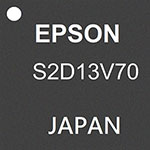Epson Shipping Samples of New Interface Conversion IC for In-Vehicle Systems
- S2D13V70 contributes to efficient development of automotive display systems -

- TOKYO, Japan, February 13, 2019 -
Seiko Epson Corporation (TSE: 6724, "Epson") has developed a new interface conversion IC for in-vehicle systems that converts eDP (Embedded DisplayPort) video signals to OpenLDI (open LVDS display interface). Samples of the S2D13V70 interface converter are now available. Epson plans to produce 100,000 of these chips per month.
Both eDP and OpenLDI are interface standards for transmitting video signals to displays, but eDP supports higher resolution video and faster speeds than the more widely used OpenLDI.
With the electrification and automation of automobiles, manufacturers will increasingly require higher resolution displays in in-vehicle systems such as instrument clusters and central information displays. As this trend accelerates, products that support eDP, which can transfer video signals at higher rates, are growing in popularity in ECUs*1 that control in-vehicle displays. On the other hand, in-vehicle displays that support eDP input are not yet mainstream, and since displays are connected using an OpenLDI interface, eDP output signals from an ECU have to be converted to OpenLDI in the development of in-vehicle systems.
To address this issue in in-vehicle systems development, Epson developed the S2D13V70, an interface conversion IC that supports automotive standards. The new product satisfies the strict quality requirements of the automotive industry. It is compliant with AEC-Q100*2 and operates at temperatures up to 105℃.
The conversion IC is also equipped with safety functions required for automotive systems. For example, a CRC function monitors whether video signals output from an ECU are being properly received, and a blank screen function masks the display with a particular image pattern when a problem is detected in the transmission path between an ECU and the conversion IC.
The IC supports the design of dual-display instrument clusters, with a splitter function that splits and outputs video signals on two displays.
Epson is committed to helping its customers improve the performance of their products with solutions that leverage its efficient, compact, and precision technologies.
- *1 Electronic control unit (ECU)
Any of various units that use electronic circuity to control a system, usually in a vehicle. Numerous ECUs are found in vehicles, where they control systems such as engines, brakes, and car navigation systems.
- *2 AEC-Q100
The Automotive Electronics Council (AEC) is an industry group that creates standards for the reliability and qualification of automotive electronics. It was formed by the "Big Three" U.S. automobile manufacturers in partnership with major electronic component manufacturers. The AEC standard is a de facto global standard that has been widely adopted as a standard for automotive electronic components.
Notes:
- See the attachment for the product specifications. (185KB)
- Please see the link below for further details about this product.
https://global.epson.com/products_and_drivers/semicon/products/interface_auto/#ac01
About Epson
Epson is a global technology leader dedicated to connecting people, things and information with its original efficient, compact and precision technologies. With a lineup that ranges from inkjet printers and digital printing systems to 3LCD projectors, watches and industrial robots, the company is focused on driving innovations and exceeding customer expectations in inkjet, visual communications, wearables and robotics.
Led by the Japan-based Seiko Epson Corporation, the Epson Group comprises more than 81,000 employees in 85 companies around the world, and is proud of its contributions to the communities in which it operates and its ongoing efforts to reduce environmental impacts.
corporate.epson/en/



